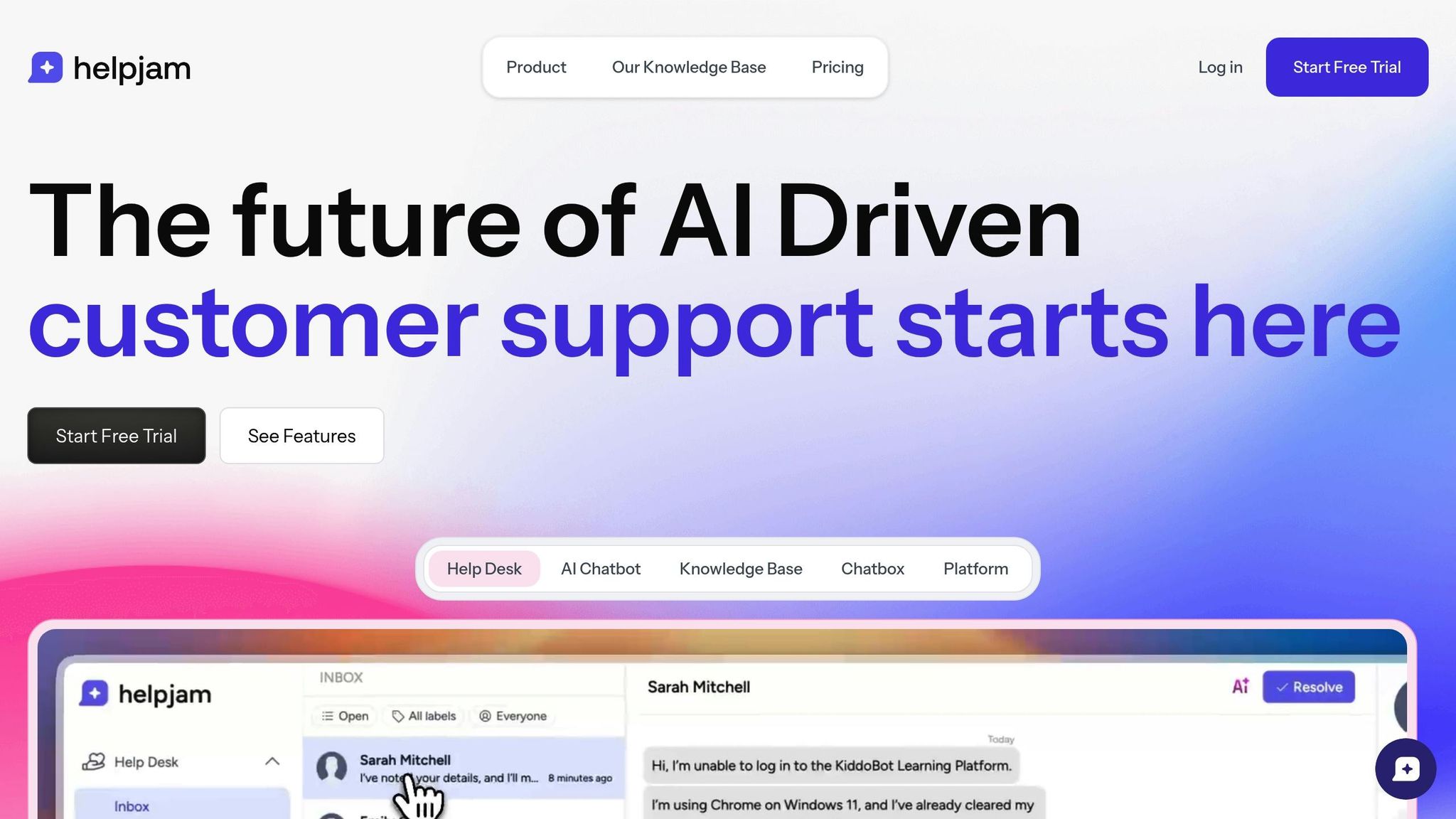Best Practices for AI Multilingual Keyword Research
Learn how AI simplifies multilingual keyword research to help businesses effectively reach global markets with local relevance.

Want to expand your business globally? Multilingual keyword research is the key.
AI-powered tools can simplify this process by analyzing search data, understanding local languages, and predicting trends. Here's what you'll learn in this guide:
- Why multilingual keywords matter: It's not just translation - it's about understanding local search habits.
- AI's role in keyword research: Automates data analysis, identifies regional search intent, and forecasts performance.
- Steps to success:
- Use AI tools with features like language detection, semantic analysis, and local search volume tracking.
- Choose markets wisely by considering size, language complexity, and competition.
- Generate, analyze, and refine keywords for regional relevance.
Quick Tip: Tools like HelpJam streamline multilingual SEO by offering AI content generation, translation, and performance tracking.
Ready to make your content resonate worldwide? Let’s dive in.
Setup Requirements
Lay the groundwork for AI-powered multilingual keyword research.
AI Tool Features to Look For
To ensure your AI tools are up to the task, prioritize these key features:
| Feature | Purpose | Why It Matters |
|---|---|---|
| Language Detection | Automatically identify source languages | Improves precision in keyword research |
| Semantic Analysis | Understand context across languages | Reduces translation mistakes |
| Local Search Volume | Track search trends by region | Aids in targeting specific markets |
| Cultural Context | Recognize cultural subtleties | Ensures accurate localization |
For example, HelpJam's text editor includes translation and cultural context tools, making it easier to adapt content for different audiences.
Picking the Right Markets
When selecting target markets, consider these factors:
- Market Size: Evaluate potential revenue and audience size.
- Language Complexity: Factor in translation needs and linguistic challenges.
- Cultural Fit: Check if your product or service aligns with local customs.
- Competition: Analyze how saturated the market already is.
Start with a few key markets to make the most impact, rather than spreading resources too thin.
Gathering Initial Data
Before diving into keyword research, collect these essential data points:
- Current Content Performance: Review how your existing content is doing in terms of engagement, conversions, and user behavior.
- Competitor Insights: Study what’s working for competitors in your target markets, identifying gaps and opportunities.
- User Behavior Trends: Gather data on regional search habits and user intent to train your AI tools for more precise keyword suggestions.
With this groundwork in place, you'll be well-prepared to start your multilingual keyword research.
Research Process Steps
AI Keyword Generation
Start by feeding high-quality seed keywords into your AI system. Tools like HelpJam's AI can analyze these keywords and suggest related terms in multiple languages.
-
Seed Keyword Preparation
Build a mix of broad and specific keywords that align with your business objectives. HelpJam's tools can assist by identifying common search patterns based on your customer interactions. -
Language-Specific Training
Use localized data to train your AI for generating multilingual keywords. HelpJam's AI, for example, can analyze content performance to create market-specific terms.
Once you've generated keywords, the next step is refining them by analyzing search intent.
Search Intent Analysis
| Intent Type | AI Focus | Strategy for Adjustment |
|---|---|---|
| Informational | Relevance and topic depth | Develop detailed knowledge base content |
| Navigational | Brand and product terms | Tailor to local search patterns |
| Transactional | Purchase-related phrases | Align with regional buying behaviors |
| Commercial | Product comparison keywords | Factor in local market preferences |
After understanding intent, adjust these keywords to better suit local market needs.
Local Market Adaptation
Adapting keywords involves more than just translation. Here's how to fine-tune them:
-
Cultural Context Review
Examine local search trends and cultural preferences. HelpJam's analytics tools can reveal how users from different regions engage with your content, helping you identify the most effective keywords. -
Regional Search Behavior
Account for local search engine preferences and user habits. For example, HelpJam's customizable chatbox adjusts to regional language preferences, ensuring customers find relevant information more easily. -
Semantic Refinement
Fine-tune keywords with AI to reflect local expressions without losing their original intent. HelpJam's AI-powered tools ensure that your content aligns accurately with regional contexts.
Keyword Selection
Keyword Evaluation
When working with AI-generated multilingual keywords, it's important to base your evaluation on actual search patterns and business goals. Key metrics can guide this process effectively:
| Metric | Evaluation Criteria | Action Points |
|---|---|---|
| Search Volume | Monthly search numbers by region | Focus on keywords with consistent traffic |
| Conversion Potential | Indicators of user intent | Match keywords to different customer journey stages |
| Language Relevance | Reflects how native speakers use terms | Confirm accuracy with native speakers |
| Competition Level | Degree of market saturation | Weigh the challenge against potential rewards |
Topic Organization
After selecting your keywords, arrange them into logical groups that cater to both global and local audiences. Tools like HelpJam's knowledge base analytics can reveal natural content clusters based on user behavior insights.
Here are some common topic clusters to consider for your core support areas:
- Product Features
- Troubleshooting Guides
- Getting Started Resources
- Account Management
- Billing Information
Each cluster should include keywords that resonate with regional search habits while keeping the core message consistent across languages.
Business Goal Alignment
Once your topics are structured, ensure the chosen keywords align with your business goals by analyzing customer interaction data. HelpJam’s multilingual tools can help identify terms that encourage user engagement.
Key Focus Areas:
-
Customer Support Efficiency
Evaluate how well your keywords guide users to relevant support content. HelpJam's analytics show that optimized multilingual content improves support outcomes. -
Market Reach
HelpJam’s adaptable chatbox interface ensures customers can easily access information in their preferred language, enhancing regional relevance. -
Filling Content Gaps
Use HelpJam's metrics to identify where your content falls short in addressing user needs. This helps prioritize keywords for creating new resources."HelpJam identifies what customers are searching for and highlights gaps to guide new content creation."
Implementation and Tracking
Content Integration
Place multilingual keywords thoughtfully throughout your content. Pay attention to these key areas:
- Knowledge Base Articles: Use HelpJam's editor to ensure consistent keyword usage across different languages. Let AI translation keep keywords relevant, and structure documents with clear headings and highlighted terms.
- Chatbox Interface: Adapt elements to fit local search habits. Leverage AI tools to offer contextually accurate suggestions.
Once integrated, measure how effectively these keywords perform using clear, actionable metrics.
Performance Measurement
HelpJam's analytics dashboard makes tracking keyword performance straightforward. Focus on these key performance indicators:
| Metric Category | Key Indicators | Recommended Actions |
|---|---|---|
| Content Engagement | Article views, time on page | Improve content that underperforms |
| Search Analytics | Query patterns, click-through rates | Fine-tune keyword targeting |
| Support Efficiency | Resolution times, satisfaction scores | Adjust content to better meet user needs |
Strategy Updates
Use performance data to refine your approach in real time:
- Continuous Monitoring: Keep an eye on search trends in different markets, track customer questions, and pinpoint areas where content is missing or needs improvement.
- AI Model Optimization: Update chatbot training with fresh keyword data and interaction trends. Fine-tune suggestions for knowledge base content.
HelpJam's analytics provide insights into conversations, resolutions, and response times, ensuring your multilingual keyword strategy stays aligned with what your audience needs and how they search.
Summary
Key Steps Review
AI-powered multilingual keyword research demands precision and a clear strategy. HelpJam's AI Co-pilot simplifies this process by helping teams:
- Create and translate content instantly while retaining SEO value
- Examine customer search behavior across various languages
- Pinpoint content gaps using advanced analytics
- Fine-tune knowledge base articles for diverse markets
These actions fuel HelpJam's global keyword strategy.
HelpJam Solutions

HelpJam revolutionizes keyword research and content creation for global audiences. Here's what the platform offers:
| Feature | What It Does | How It Helps |
|---|---|---|
| AI Co-pilot | Quickly creates and translates articles | Produces content and translations in seconds |
| Multilingual Knowledge Base | Supports unlimited languages (Business plan) | Expands reach into global markets |
| Advanced Analytics | Tracks performance in real time | Spots trending searches and content gaps |
| SEO Optimization | Built-in tools for SEO | Boosts visibility across multiple languages |
"Meet your AI Copilot: Experience Next-Level Writing" - HelpJam
HelpJam combines these features with pricing that adapts to your business size. Plans start at $49/month for essential features and go up to $199/month for unlimited languages and AI credits.





